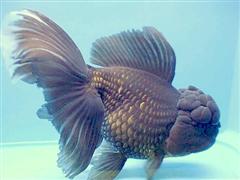Goldfish - Red and Black Oranda
Oranda Goldfish, Red & Black Oranda Scientific Name: Carassius auratus
Fri, 11th April, 2025 - 11:23 pm GMT
Sponsor Ads:

Alternative Name
Oranda Goldfish, Red & Black Oranda Scientific Name: Carassius auratusBasic Info
Red and Black Oranda Goldfish are most easily recognized by the the striking contrast between their colors and interesting head growth, which is called a "wen". It is interesting to note that these Orandas are born without a wen. Rather it develops as they mature. The actual size of the head growth will vary between individuals. Generally speaking it is a warty type of texture that can grow so large that it is difficult to see the eyes. Head growth takes one to two years to fully develop. To ensure good head growth make sure that fish receive proper nutrition. Most Red and Black Orandas are actually closer to orange and black since the red is usually light colored. They are quite striking fish. The mature Red and Black Oranda measures 8 to 10 inches in length. Oranda Goldfish have long fins, including a dorsal fin. They have veiltail type tails and double caudal fins. The caudal fins are divided down about 90 percent of their length. Oranda Goldfish can have caudal fins that are about one and a half times the length of their bodies. The pelvic and pectoral fins are usually rounded and of medium length. They are well matched in size and appearance.
Health
The Red and Black Oranda does best when kept in an aquarium that is at least 30 gallons. Water temperatures should be maintained at an average temperature of 78 degrees Fahrenheit with pH kept between 6.5 and 7.5. Because ammonia can damage their fins, it should be kept to a minimum. Often, a filtration system that does not create too much water turbulence will be appropriate. The aquariums of Red and Black Oranda Goldfish should allow them plenty of hiding places. Cleaning should be accomplished with gradual, or partial, water change. The Red and Black Oranda is an omnivore and should be fed a varied diet. Their diet can include formulated foods as well as live food and plants. Formulated Goldfish flakes or pellets will often provide all of the necessary nutrition. Some hobbyists choose to feed color enhancing foods as well. It is important to note that too much protein is not good for this species. Many Red and Black Oranda Goldfish have been killed with overfeeding, so you should stick to a set diet to keep your fish healthy. Breeding Male Red and Black Oranda Goldfish usually indicate a readiness to breed by developing small white tubercles over their gill coverings, pectoral fins, and heads. Because parents will often eat eggs, they should be removed from the enclosure where spawn are deposited. These fish can produce thousands of eggs.Habitat
Fresh water fishBehavior
The Red and Black Oranda is a popular variety of the already popular Oranda goldfish. Red and Black Oranda Goldfish are peaceful fish and do well with other fish of similar temperament. Examples of good tankmates include Comet Goldfish, as well as other Fancy Goldfish. Plecostamus also make good algae eaters in an Oranda tank. Red and Black Oranda Goldfish do require warmer waters than some other goldfish varieties, however, and thus should not be kept outside in ponds or in cooler enclosures. Red and Black Orandas are usually seen swimming in the middle areas of the tank, the are even reported to school with other fish.Origin
ChinaHistory
Red and Black Oranda Goldfish were probably first developed in China, though the Japanese have also kept such fish for centuries. Today they are valued as exhibition fish and as pets.Common Foods
AlgaeSponsor Ads:
"He that violates his oath profanes the Divinity of faith itself." - Cicero (found on LA City Hall)
Goldfish - Red and Black Oranda
Coded by: BGID® | ALL RIGHTS RESERVED Copyright © 2000-2025
Disclaimer | Privacy | Report Errors / Contact | Credits








 Preparing For China. China is growing their military. China Military Technology - can it keep up with the US?
Preparing For China. China is growing their military. China Military Technology - can it keep up with the US?  versus
versus 

 versus
versus 
 This Thread is about the North Korean Military itself - the kind of army, navy, and air force they have.
This Thread is about the North Korean Military itself - the kind of army, navy, and air force they have. 
 versus
versus 
 versus
versus  versus
versus